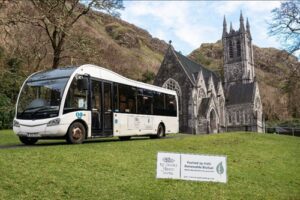 As the world dons shades of emerald to celebrate St. Patrick’s Day, Ireland is showcasing its green in a remarkably different spectrum. Beyond the festivity’s verdant veneer lies a more profound commitment to sustainability, positioning the Emerald Isle as a leader in eco-friendly tourism and hospitality. This transformation is about honouring heritage and spearheading a movement towards a sustainable future, setting a global benchmark.
As the world dons shades of emerald to celebrate St. Patrick’s Day, Ireland is showcasing its green in a remarkably different spectrum. Beyond the festivity’s verdant veneer lies a more profound commitment to sustainability, positioning the Emerald Isle as a leader in eco-friendly tourism and hospitality. This transformation is about honouring heritage and spearheading a movement towards a sustainable future, setting a global benchmark.
Ireland’s ambitious goals to slash greenhouse gas emissions by 50% by 2030 and to achieve net-zero emissions by 2050 are commendable. These targets are mirrored across the hospitality and tourism sectors, where a significant shift towards sustainable practices is underway. From eco-conscious hotels to festivals and major attractions, Ireland is crafting an environmentally friendly blueprint for others to follow.
Dublin, now hailed as the 2024 ‘European Capital of Smart Tourism’, is at the forefront of this green revolution. The city’s commitment to sustainability is evident in its expanding public transportation network, the Dublin Bikes scheme, and extensive cycling routes that encourage low-carbon exploration. Such initiatives exemplify Dublin’s dedication to creating a greener, more inclusive, innovative urban environment.
The Iveagh Garden Hotel, Europe’s first sustainable hotel, is leading the charge in sustainable accommodation. Its opening in 2018 set a precedent, inspiring establishments like the Wren Hotel to adopt eco-friendly practices. Across the island, from the luxury Salthouse Eco-lodges in County Antrim to the Falls Hotel and Spa in County Clare, green hospitality options are emerging, offering travellers eco-conscious alternatives.
The initiative to ban single-use coffee cups in Killarney, County Kerry, underscores Ireland’s commitment to combating plastic pollution. This pioneering move is projected to divert over a million disposable cups from landfills annually. Furthermore, Powerscourt Estate and Gardens in County Wicklow leads by example, being the first major tourist attraction to meet global sustainable tourism standards.
In County Galway, Kylemore Abbey is embarking on a sustainability journey. It employs HVO biofuel for its gothic church and shuttle buses, significantly reducing emissions. This is part of a broader estate strategy focusing on biodiversity, including invasive species control and native tree planting, in collaboration with the University of Galway.
The Irish Boat Rental Association’s shift to biofuel aligns with the nation’s green agenda, making river cruising an eco-friendly experience. Festival organizers, too, are embracing sustainability. The PUCA Halloween festival and the Wander Wild Festival in County Kerry have introduced reusable cups, enhanced public transport, and policies against single-use plastics to minimize their environmental impact.
Ireland’s Hidden Heartlands is poised to become a leading destination for regenerative tourism. Key initiatives like the peatland rehabilitation project, Europe’s most significant nature conservation effort, aim to restore peatlands to their natural, carbon-absorbing state, supporting biodiversity and promoting ecological balance.
Ireland’s journey towards sustainability is a testament to its commitment to preserving the planet for future generations. Through innovative practices and ambitious goals, the island serves as a beacon of hope and a model for sustainable tourism worldwide. As the global community celebrates Ireland’s cultural heritage, the country’s green revolution may leave a lasting legacy, inspiring nations to embrace a sustainable future.
Written by: Michelle Warner

















Trackbacks/Pingbacks